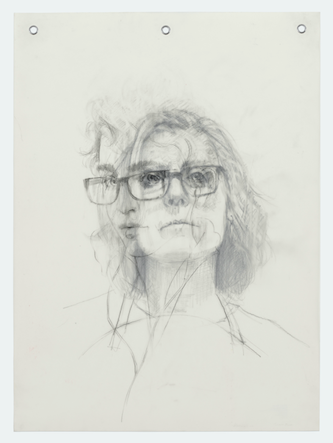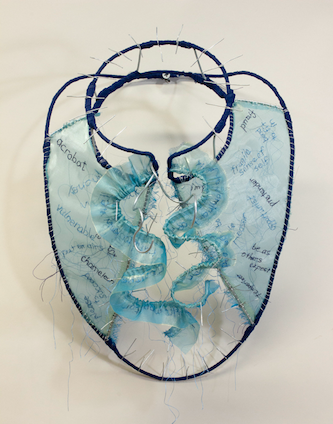Visual Arts Review: “Burning Down the House” — A Female Chorus of Concern
By Kathleen Stone
These five artists do indeed make their voices heard. They shine as soloists, and their messages are only amplified when they join into a chorus of multipart harmony.
Burning Down the House: Women and Art in an Uncertain World at the Brickbottom Gallery, Somerville, through February 11.

Kim Triedman, In the Garden, collage on reclaimed window, 48” x 32” (diptych). Photo: courtesy of Kim Triedman
So many things to worry about. Far away wars, nearby violence. Politicians craving power, facts be damned. Hard lines drawn, others demonized. Values abandoned, opportunities lost. Aspects of our contemporary moment like these affect both men and women, but some things affect women more. Sexual assault, for instance. Also pregnancy, motherhood, and choices about health care. This superb group show at Somerville’s Brickbottom Gallery makes it clear that women artists see what’s going on and have plenty to say about it.
The artists work in different ways and mediums: drawing, photography, collage, assemblage, fabric, and words. Some of their images are ethereal, merely suggestive. Others are explicit, very on-the-nose. Kim Triedman, an artist who works in collage and also curated the show, told me that the variety reflects five individual ways of seeing and capturing this troubled moment in history. The artists, in addition to Triedman, are Virginia Mahoney, who works with reclaimed fabric; Lorraine Sullivan, who uses found objects to construct her pieces; Tira Khan, who melds photographic images with wallpaper-like backgrounds; and Kathryn Geismar, who draws and paints. As individual as these artists are, their work presents a coherent vision in this group show. In fact, not only does the work cohere, but some pieces, though seemingly very different, fit together like puzzle pieces.
One of Triedman’s collages, In the Garden, portrays Adam and Eve. The two occupy separate panels but face toward one another. Adam looks lustful. Eve, on the other hand, seems bored with his antics; with legs crossed, lips pursed, and a hand placed resolutely on her hip, she uses body language to signal a different approach to temptation. Temptation comes up again in Lorraine Sullivan’s piece The Near Occasion of Sin, assembled from vintage found objects. The piece was inspired by her early experiences at a Catholic school, where nuns instructed the girls to cross their legs in order to tame the boys. Sullivan wondered why it was a girl’s responsibility to keep the boys away. Could boys not be expected to tame themselves? Seen together, Triedman’s and Sullivan’s works sketch a timeline about gender conventions that stretches from the Old Testament to the recent past, and on to today.
Other collages by Triedman are highly evocative, leaving the viewer to intuit the message. Sorrow, Sorrow, Repeat shows a tiny dress of sheer fabric, perhaps what a baby would wear at her own funeral. Beneath the dress perch two yellow birds, one with a ribbon in its beak, gazing upward. We don’t know the circumstances behind this sorrowful image, but the empty dress makes the sadness palpable.

Kathryn Geismar, Motherlove, graphic and grommets on Duralar and paper, 33” x 24.” Photo: courtesy of Kim Triedman
Tira Khan is a photographer who embeds her pictures in decorative backgrounds that resemble old-fashioned wallpaper. She enjoys playing with Charlotte Perkins Gilman’s 1892 allegory “The Yellow Wallpaper.” Now considered a classic of feminist literature, the story features a woman who, while confined to her bedroom, becomes mentally unhinged and tries to free the woman she sees trapped in the room’s wallpaper.
In Khan’s hands, women’s bodies melt into the wallpaper. We believe we can make them out, but blink, and look again, just to be sure. In The Conversation, a young woman stares over her shoulder at a faded version of an older woman in period dress. We don’t know who they are or what their relationship is, but we can surmise that the younger woman is looking at the more experienced one for advice on surviving tumultuous times. In The Sconce, a woman is poised to run away — from what we don’t know. But she won’t get very far because the wallpaper ensnares her. Perhaps the suggestion is that Gilman’s protagonist will try to liberate her.
Virginia Mahoney uses words and fabric to express her views. Her working process involves constructing a metal form and draping it with sheer fabric onto which she has stitched words. You have to get close to make out the words, but once you do, the message is clear. Is This U.S.? features red and blue fabric and phrases such as “gamification of politics,” “deference to power in service to ambition,” “mockery of democratic values,” and “existential threat to democracy.” Less ideological and more feminist, People Pleaser presents fabric arranged to resemble a frilly blouse. The stitched words include “acrobat,” “vulnerable,” and “chameleon.” The culminating phrase is “fragile sense of self.”
In a way, Kathryn Geismar’s work is the most traditional of the five. She excels in figurative drawing and painting; her materials include graphite, ink, and acrylic paint. Yet her subject matter is not traditional. Geismar’s child, Sam, has transitioned to female. The result is that gender identity, with its many ramifications, has become a focus of her work. She explores the subject lovingly, with images that invite reflection. No hard lines, no screaming colors. Instead, her pencil lines are just soft enough to hint at ambiguity.

Virginia Mahoney, People Pleaser, steel, reclaimed fabric, thread, 13” x 10” x 8.” Photo: courtesy of Kim Triedman
In Olympia, a large drawing that visitors see when they first arrive at the gallery, a figure lounges on a sheepskin rug, naked except for a taut band around the chest. The allusion is clear, both to Manet’s famous painting and to the scandal it triggered in late 19th-century Paris. Yet there are important differences. There is no Black maid offering a bouquet of flowers and here pointy animal-skin shoes adorn the woman’s feet. In addition, a noticeably large hand rests on the genital area. Maybe the figure is Sam. Or maybe the drawing captures an aspect of the artist herself. As Geismar writes in her artist statement, she underwent aggressive treatment for breast cancer, leaving us to wonder if the band across the chest reflects her own experience.,
Sometimes Geismar draws several images on translucent polyester film and binds them together so that we see them as one picture rather than multiples. This strategy enhances the drawing’s ambiguity. The technique is particularly effective in Motherlove, a dual portrait of the artist and her much-loved child in which the artist insinuates questions about identity, individuation, and parenthood. We are invited to think carefully about a number of issues.
Confronted by so much turmoil in the world, where can we find a bright spot? Lorraine Sullivan suggests one with a figure titled Hazardous Voting. A gas mask stands in for a head, and the chest sports “I Voted” stickers, the sort handed out at polling locations. Text supplied by the artist recounts her voting experiences; she feels proud when she presses a sticker onto her coat. At the same time, Sullivan cannot help but remember the many women in the past who did not have the privilege of voting. “Now, more than ever, we must make our voices heard,” she writes.
These five artists do indeed make their voices heard. They shine as soloists, and their messages are only amplified when they join into a chorus of multipart harmony.
Kathleen Stone is the author of They Called Us Girls: Stories of Female Ambition from Suffrage to Mad Men, an exploration of the lives and careers of women who defied narrow, gender-based expectations in the mid-20th century. Her website is kathleencstone.com.
Tagged: Brickbottom Gallery, Burning Down the House, Kathryn Geismar, Kim Triedman, Lorraine Sullivan, Tia Khan

Thank you very much for this thoughtful review!
Alexandra R.
Thank you for this detailed and insightful review! Much appreciated.
Thank you for this review, you seemed to understand all the work — and described it all so well!